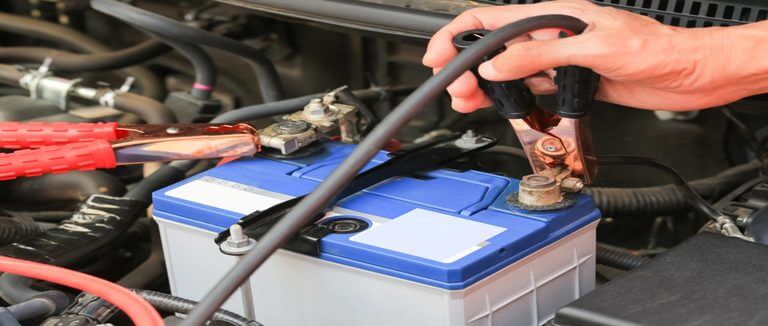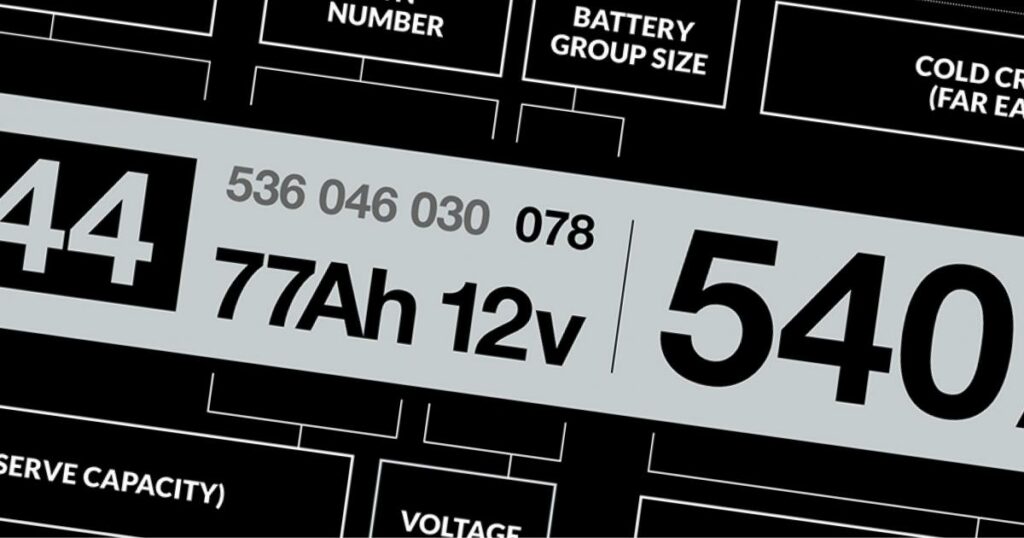
Whether you’re looking to purchase a new car battery or you’re trying to figure out what charger you need, having a thorough understanding of the electrical principles that make up a car battery is essential.
That’s why we took the time to break down everything you need to know about car battery amps here. Because when it comes to answering the question of how many amps are in a car battery, it’s impossible to give a simple answer.
What Are Amps?
While voltage gets all the credit, it’s the amps that do the work! An essential electrical concept that gets taught to every mechanic is Ohm’s Law. In short, it means that it takes 1 volt to push 1 amp through 1 ohm of resistance.
Since every component in your vehicle has at least some resistance without any amps, it doesn’t matter how much voltage you have! So, what are amps? They’re the force your battery needs to push the voltage throughout the car to where it needs to go.
Average Car Battery Amperage

The average car battery has 48-amp hours and anywhere from 550 to 1,200 amperes. 1 amp hour means that a batter can push 1 amp for one hour. Meanwhile, a 48-amp hour battery can either push 1 amp for 48 hours or 48 amps for 1 hour.
This isn’t a huge thing to consider until you’re charging batteries, then it’s a critical number to consider when determining how long to leave the battery on the charger.
The overall battery amperes is a more practical number to consider when selecting a car battery. That’s because these refer to how many amps your battery can push with an ambient temperature of 0° Fahrenheit for 30 seconds while still maintaining 7.2 volts.
This might seem like an arbitrary measurement – and in many ways it is – but what it signifies is far more important. Because a battery with more cold cranking amps will do two things. First, it will make it easier to start your vehicle in colder temperatures.
So, if you live somewhere with frequent dips into frigid temperatures, you should invest in a more powerful battery. This is something we all understand a little, even if we don’t get the science behind it, and it’s why you’re more likely to have a hard time starting your vehicle in the winter.
But you also need a more powerful battery depending on what you drive. This makes sense because the larger the engine in your vehicle, the more power the starter needs to turn the entire engine over. So, if you’re driving a four-cylinder Dodge Dart, you don’t need the same battery that you would use to start a V12 Ford Super Duty.
How Many Amps Do You Need To Charge a Car Battery?

Often, drivers don’t even realize their batteries have amps until it’s time to charge them. Then they’re looking at different battery chargers trying to determine which one is best for them.
So, how many amps do you need to charge a dead car battery? The truth is that even a 1-amp car battery will charge a completely dead battery. All the number of amps changes is how long it will take.
However, while more amps will charge a battery faster, it’s always best to stick with as few amps as possible as long as you have the time. That’s because the more amps you use to charge the battery, the more you’ll reduce its usable life. So while it’s a minor impact if you’re only doing it once or twice, the more it happens, the more it will reduce the battery’s lifespan!
How Long Does It Take for a 1-Amp Battery Charger To Charge a Battery?
The most significant factor that determines this is how dead the battery is. And if you’re using voltage to determine this, you might be surprised how quickly you lose amperage. So while the following chart isn’t completely foolproof, it’s a great way to get a general estimate.
| Battery Voltage | Percent of Charge Remaining |
| >12.6 | 100 percent |
| 12.4 | 75 percent |
| 12.2 | 50 percent |
| 12 | 25 percent |
| <11.9 | <25 percent |
From there, you multiply the percent of the charge remaining by the number of amp hours your battery is supposed to have. So, if you have a 48-amp hour battery at 12.4 volts, it’s actually at 36-amp hours.
Since a 1-amp charger can push 1-amp per hour, it will take 12-hours to get back to a full charge! Meanwhile, it will take up to 48 hours for a full charge for a completely dead battery!
However, keep in mind that the chart is not foolproof. As batteries age, the chart will become less reliable. For instance, a defective battery might read 12.6 volts and have zero effective amps. So it doesn’t matter how long it sits on the charger; it’s never going to start your vehicle.
How Long Does It Take for a 2-Amp, 5-Amp, or 30-Amp Battery Charger To Charge a Battery?
Determining how long it takes to charge a battery with a different amp charger utilizes the same formula we mentioned above, but when you get to the point of determining how many amps your battery needs, you divide by the number of amps you need by the number of amps you charger can push.
So, a completely dead 48-amp hour battery would need:
- 24-hours with a 2-amp charger
- 9.5 hours with a 5-amp charger
- 1.5-hours with a 30-amp charger.
Keep in mind that no matter how many amps you’re pushing, it’s critical that you don’t overcharge the battery. Pumping too many amps into the battery will cause the battery to overheat and swell. Eventually, if you don’t remove the charger, the battery will explode!
If you don’t have a charger that will automatically shut off when it detects a completely charged battery, make sure that you’re checking on the battery regularly as it charges that way, it doesn’t overheat and cause any damage.
Final Thoughts

Hopefully, after reading through this guide, you have a better understanding of how amps are in your car battery and why they matter so much. Whether you’re looking for a new battery or charging an old one, you need to look at the amps, not the volts.
Because remember – while the volts get all the credit, it’s the amps that do the work!








